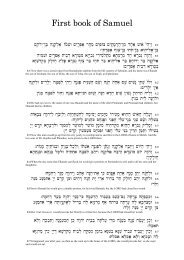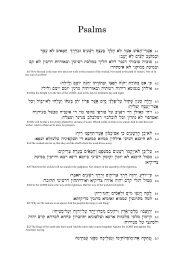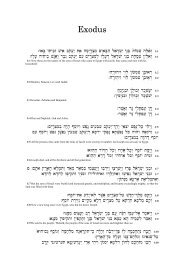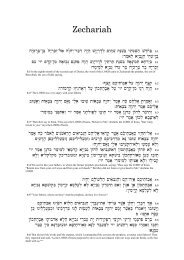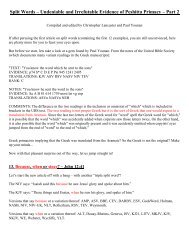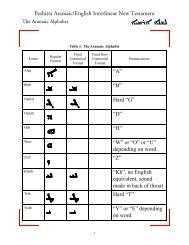ana translation
Untitled - Peshitta Aramaic/English Interlinear New Testament
Untitled - Peshitta Aramaic/English Interlinear New Testament
- No tags were found...
You also want an ePaper? Increase the reach of your titles
YUMPU automatically turns print PDFs into web optimized ePapers that Google loves.
INTRODUCTION<br />
xliii<br />
presented some thirty years later to the monastery of the Theotokos,<br />
in the Nitrian Desert. It bears date A. Gr. 1 134 (A.D. 823), being thus<br />
older by at least three centuries than any of our other MSS which can<br />
be dated with certainty. Its age thus gives weight to its textual<br />
authority : while, on the other hand, we are to remember that it is<br />
later, also by three centuries, than the time of Philoxenus ;<br />
an interval<br />
long enough for the entrance of many<br />
errors into the text had it been<br />
transmitted to our scribe by less competent or careful copyists. It is<br />
on vellum, palimpsest, written in a clear, cursive script, and in good<br />
preservation. This MS, and Codd. 2, 3, 4, 5, 6, belong to the great<br />
Nitrian collection acquired by the Museum in 1839-47.<br />
Cod. 2. (Br. M., Add. 14473(2), Catal. cxxxn.)<br />
An undated MS of which the age cannot be determined with confidence.<br />
Dr. Wright's opinion is, "of about the xith century." But its<br />
script<br />
gives no trustworthy evidence in the matter, for it is evidently<br />
not the normal handwriting of the scribe, but a somewhat clumsy<br />
attempt to imitate the fine estrangela character of the MS (see Catal.<br />
cxxvi) to which it is appended, a copy of the Acts and Three Epistles<br />
(Peshitta). It consists of nine leaves of vellum, supplying our Four.<br />
Its text agrees closely with Cod. 1 in most of the crucial passages, and<br />
even in its most notable misreadings, as noted above (2 Pet. iii. 2, 4,<br />
and 7, in the second of which 1 and 2 stand alone), and also in the<br />
remarkable double aberrant reading in Jud. 24.<br />
It avoids, however, in<br />
2 Pet. ii. 13 the .OOuAwJ of Cod. 1, yet inconsistently adopts<br />
it in<br />
the parallel, Jud. 12 (correcting it, however, in the margin). Yet its<br />
agreement with Cod. 1 is so much less strong in 2 and 3 John* than<br />
in 2 Pet. or Jude, as to suggest the suspicion that in 2 and 3 John<br />
the text follows a different exemplar. But on the whole, while there<br />
is<br />
enough of divergence between Codd.l and 2 to preclude the supposition<br />
that 2 was copied from 1, their internal evidence proves them to<br />
represent a common archetype.<br />
Hence follows the important inference,<br />
that the readings common to 1 and 2 (which, as we shall see, are the<br />
readings for the most part which characterize group A)<br />
were not<br />
originated by the scribe or editor of 1, but represent an earlier<br />
authority how much earlier we cannot tell.<br />
* See notes infr. on Syr. text, 2 Job. 1, 5, 8, 13 ;<br />
3 Job. 4, 6, 7, 9.



